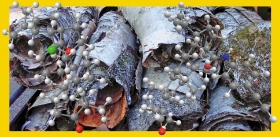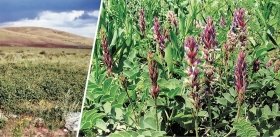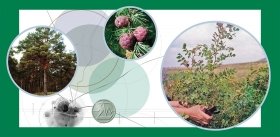Transformations in Solid Phase. Innovation Technologies of Mechanochemistry
It was Aristotle who wrote that solid substances could not react with each other because their elements did not have mobility. It seems that the validity of this statement is confirmed by the experience of our whole life. However, as the humankind was acquiring technological skills (starting from the methods of producing fire in the primeval times), facts proving that chemical reactions could take place in solids under mechanical or other impacts were also being accumulated. Still, mechanochemistry as a science was not born until the second half of the last century
Everyone knows from their own limited school experience that the easiest way to carry out a reaction between solids is by previously melting or dissolving them. All standard processes of chemical technology are also carried out through the liquid phase even if a solid product is prepared from a solid precursor.
Everything has changed with the appearance of a new field of science — mechanochemistry, which was born from physical chemistry and solid state chemistry. It appeared that molecules of substances in the solid state could exchange energy and interact with other molecules, i. e. participate in chemical reactions under the action of heat, ionizing irradiation or mechanical impact. Due to technological methods based on solid-state mechanochemical reactions, precursors can now be converted into a final powder product in one stage.
The advantages of such approach are obvious: shortening the technological cycle, decreasing material and energetic expenses, and meeting strict ecological requirements. Naturally, it is impossible to jump over some stages in the technological chain. Still, the main idea of mechanochemistry—to combine the stages of grinding, mixing and chemical reactions—has already proved its justifiability and prospects in practice. Demonstrative in this aspect are projects developed at the Institute of Solid State Chemistry and Mechanochemistry SB RAS.
Vegetable Klondike
The processing of vegetable feedstock has appeared to be one of the most gratifying applications of mechanochemical approaches. Impressive results have already been obtained here. However, let us first figure out what vegetables are from the mechanochemistry standpoint.
As scientists say, vegetable feedstock is a composite material. It has a complex structure and contains many components. Cells of higher vascular plants (e. g. cereals) can be either unlignified or lignified. In the former case, the cell walls contain only structural carbohydrates—cellulose and hemicellulose. Therefore, they are easily crushed during mechanical processing. Meanwhile, lignified cells contain also lignins. These are complex chemically stable polymers making cell walls very strong.
The basic idea of mechano-chemical technologies is to carry out reactions in the solid phase, thus shortening the technological chainDifferent mechanical behavior of the composite components can be used for the vegetable feedstock enrichment and separation of the necessary structural carbohydrates, celluloses and hemicelluloses (totaling 50—60 % of the dry weight), from less important lignins.
The lists of the American “green chemistry” program, where colossal amounts of money are invested by the government, include thousands of valuable chemical products that can be prepared from the structural carbohydrates of vegetable feedstock. Furthermore, note that this feedstock is renewable! In this country, vegetable feedstock from this standpoint interests only people involved in the development of technology for synthesis of biological fuel.
Still, among the chemical substances present in vegetable cells special interest is attracted by the components of the intracellular space. These include all the most popular biologically active substances—alkaloids, organic acids, glycosides, etc. It is in this area where the interests of mechanochemists and “traditional” chemists overlap. Therefore, special attention is attracted by such applications of the mechanochemical approach where its advantages can be utilized to the maximum degree.
As an example, let us mention processing of lean feedstock, which is economically unprofitable to be processed by traditional extraction methods. Scientific problems in this area are of a more local nature: their solution does not require powerful mechanochemical equipment and a practical result can be obtained faster.
When intracellular biologically active substances are prepared by traditional methods, vegetable feedstock is powdered and covered with an organic solvent. Then, the extract obtained after several extraction procedures is used to isolate the desired components (if needed, they are additionally purified to pharmaceutical purity grade). Although new approaches to extraction are being developed today, the cost of obtained materials remains high.
Note that biologically active substances exist in plants in different chemical forms. For example, an organic acid can be present not only in its free form but also as a salt, ester, glycoside, or be bound with practically insoluble cellulose or lignin. If feedstock is treated with one selected solvent, only the form soluble under these conditions will be extracted. The rest will be lost.
Now imagine that we convert all these different forms into one form that is extracted most successfully. Moreover, it can be extracted with water rather than an organic solvent. It is well known that solubility in water is a prerequisite for a substance to be accessible to a living organism. To put it differently, we make valuable components of the vegetable feedstock react with a solid reagent and obtain a powder containing the desired biologically active substance in soluble form. Further extraction with water will not only allow obtaining more product than extraction with organic solvents, but in some cases even get a product of better quality.
If concentration of an active substance in a biologically accessible form of a powder product is rather high, a simple idea comes to mind: why should we extract it after all? For some practical applications, several additional grams of residual vegetable materials in the products is not important. In return, it is possible to organize production with low initial expenses, certify the product and bring it to the market. That is why at the Institute of Solid State Chemistry and Mechanochemistry (ISSCM), SB RAS we started developing products for animal husbandry, veterinary medicine, and plant cultivation rather than for medicine. It is in these areas where our technologies and products have a chance for going into practice in present-day Russia.
Technological benefits
Investigations of solid-state mechanochemical reactions yielding water-soluble products formed the scientific basis of the new technologies being developed at ISSCM, SB RAS. Judging from the reviews published on the so-called “reactions without solvents”, there is still plenty of work in this area. ISSCM has been working with special mill-activators for mechanochemical reactions for almost 40 years.
The term “nanogrinding” must be a coinage of the quasi-scientific PR. However, sometimes it is indeed possible to alter the structure of a cellular substance at nanoscale to improve its reactivitySize reduction is the first stage in the technological chain of processing the vegetable feedstock. Increasing the grinding efficiency of the vegetable feedstock means both making it more active in any subsequent heterogeneous chemical reactions and turning out more final product at the available production facilities using the same energy expenses.
The grinding efficiency can be improved by preliminary chemical or biological processing that would destroy bonds between the main macrostructural elements, e.g. between lignin and hemicellulose. Imagine a multistoried panel building with interpanel welded joints consumed by rust. It would not be hard to stack it or pull it apart.
Such processing produces extended defects in the feedstock. In most cases it possible to combine chemical treatment with the mechanical one. Such treatment is referred to as preliminary mechanochemical processing. Fine grinding is also achieved by selecting optimum conditions of the mechanical treatment taking into account the composite structure of the feedstock.
Solid-state chemists know that for a chemical reaction to take place it is not enough to make the particles of a substance small. It is also necessary to alter their ultrastructure by introducing point and linear defects. Such defects affect the mechanical properties in about the same way as perforation in places of contact between postage stamps. As for reactions, chemical transformation is a very efficient channel for discharge of excess energy accumulated by point and extended defects.
Experiments in the mechanochemistry of vegetable feedstock have brought us many pleasant surprises. For instance, it was found that it is not always necessary to lead the mechanical processing to the final product stage. Often it is possible to do without unnecessary mechanical energy expenses and stop at the stage of forming the so-called mechanocomposite, consisting of well-mixed particles of the vegetable feedstock and the solid reagent with dimensions of tens to hundreds nanometers. Chemical reactions in such a mixture of highly reactive components can be very fast.
Owing to the original technological advances, in many cases we have managed to increase the product yield by a factor of 1.5—2.0 compared to conventional extraction methods. Furthermore, sometimes it is possible to increase the selectivity as well. After all, during extraction all soluble substances are dissolved, not just the desired ones, whereas during mechanochemical processing most of the product is formed in a certain chemical reaction.
Moreover, sometimes even more active components can be obtained. For example, during analysis of the mass spectra of a mechanochemical product containing triterpene acids we found that acids with two carboxyl groups were present in it, in addition to the acids with one carboxyl group present in the standard product. Such more soluble and biologically active components remain in the wastes in the case of conventional extraction.
Doping for pigs
The mechanochemical method has enabled us to produce many promising preparations at ISSCM, SB RAS. One fine example is ecologically benign substitutes of forage antibiotics. The latter are banned in the European agriculture because the products of their metabolism get in the human organism thorough meat and lead to undesirable consequences.
Mannanoligo-saccharides obtained from the cell walls of microorganisms (yeasts and funguses) are used as antibiotics substitutes. These substances interact with the agents of infectious diseases preventing them from sticking to the walls of the digestive tract. The products based on this principle are still being imported from the USA. However, poultry tests of the products with high concentration of accessible mannanoligo-saccharides produced at ISSCM, SB RAS have already started.
The already mentioned triterpene acids obtained from conifers can be used instead of expensive plant growth regulators. High efficiency of powders with triterpene acids has been confirmed by the Russian Academy of Agricultural Sciences using both cell cultures and experimental fields. Their application was proven to improve the seed germinating ability, accelerate their growth and substantially increase the plant productivity.
An interesting story is connected with the so-called phytoecdysteroids. Some time ago evil tongues in the West used to say that success of the Soviet sports was largely due to a good knowledge of chemistry of these phytohormones, which could not caught by the doping control. What are they made of? There is a plant called Maral root growing wildly and cropped in Siberia. The root of this plant included in the recipes of the well-known soft drinks “Baikal” and “Sayany” contains phytoecdysteroids. The above-ground part of the plant also contains them, although in smaller amounts. So, it is unprofitable to extract them from the “tops” by the conventional method. At the same time, the mechanochemical product is so cheap that it can be used not only in body-building, but also for feeding pigs. It accelerates their growth and improves many other characteristics.
Substances with similar effect can be also produced from the wastes of the farming industry. For instance, millet husk contains a lot of phytosterols. However, it does not make sense to use husk as a forage additive: the phytosterols are not assimilated in the animals’ digestive tract. In a mechanochemical product though, they are converted into a soluble complex. The efficiency of this product was tested on pigs, partridges, domestic birds (at Kochenevo poultry farm – one of the largest in the Novosibirsk Oblast). The result was 20 % weight gain increase!
However, for us the main mechanochemical “topic” related to nutritional supplements is the development of technology for production of antioxidant materials containing soluble chelated silicon forms. The material is produced from rice husk: silicon dioxide present there is converted into a soluble form using gallocatechins of green tea. We are participating in a big program of the Moscow government on provision of certified antioxidant products to the Moscow market.
What is the soluble silicon needed for? There are reports that the mechanical strength of bones and egg shell containing calcium phosphates and carbonate, respectively, also depends on the presence of silicon. Therefore, preparations of soluble silicon are promising for prevention of osteoporosis, especially in elderly age. Improvement of the egg shell strength has also become an urgent problem as it decreases the egg breakage in fully mechanized modern poultry farming.
Products of cooperation
Surprisingly, the most interesting mechanochemical ideas spring from cooperation with specialists engaged in seemingly distant branches of science.
For instance, cooperation with the scientists from the Institute of General and Experimental Biology, SB RAS (Ulan-Ude) has brought us to the discovery of the totally unstudied technology for the production of ancient Tibetan medicines. It appeared that the ancient pharmacists utilized some mechanochemical methods, especially for preparation of medicines from metals. Reproduction of the technology from a thousand-year-old treatise came in as a great surprise for the researchers. The obtained solid silver material maintained a buffer silver concentration in the solution above it equal to 1 mg/l (which is precisely the concentration recommended for medical use).
Today our main partner in the developing the mechanochemistry of vegetable feedstock (particularly, peat) is the Institute of Petroleum Chemistry (IPC), SB RAS (Tomsk).
Investment exceeding 100 million dollars is required to adjust a laboratory technology to industrial productionRussia is rich in peat deposits containing as much as 40 % or more humic substances, originating from the dead parts of vegetables forming the basis of soil fertility. Humic substances are complex heteropolymer macromolecules containing a number of valuable components of different chemical origin – polyphenols, polysaccharides, lipids, etc. Our main task is to extract them selectively from there and modify them in a desired way. Together with IPC, SB RAS we managed to find selective mechanochemical reactions making it possible to separate different types of humic substances and create original technologies for production of next-generation humic materials from peat.
Institutes of the RAS Siberian Branch now participate in the project “Mechanochemical disassembling of heteropolymer macromolecules – technology of the nearest future”. It is planned to build a number of peat processing plants based on its results.
The new mechanochemical materials are so effective and economically profitable that seemingly they should have a free pathway to production. However, the problem of certification arises. For example, when we were working on development of a cheap analog of soluble aspirin, necessary for everyone, most of the funds allotted to us had to be used as a fee for the approval of the pharmaceutical clause — permission for using the medicine in medical practice. It takes about 15 years and several million dollars to put a pharmaceutical product into practice. Realists have to turn to the development of components for functional nutrition and food supplements. This also takes several million, but rubles.
In general, our scientists and manufacturers do not always understand how much investment is required to adapt a laboratory technology to industrial production. Based on our own experience we can estimate approximate expenses: up to 1 million dollars is required for the research, about 10 million dollars should go to a specialized design company, and about 100 million dollars is the cost of an operating plant itself. It is impossible to finance the whole chain without participation of the state or large private investors. However, academic institutions can participate at the first stage.
Unfortunately, this brings other, political and economic, problems. A serious investor can make such a financial contribution to a Russian project. However, he or she usually has no intention of preserving the rights of the academic institution to the intellectual property. Interaction between academic science and private businesses remains to be governed by law, which does not help to put the results of basic studies in practice.
References
Lomovskii O.I., Boldyrev V.V. Mechanochemistry in solution of ecological problems: analytical review.—Novosibirsk: SPSTL SB RAS, 2006.—211 p. Series: Ecology, Iss. 79.
Korolev K.G., Lomovskii O.I., Rozhanskaya O.A., Vasiliev V.G. Mechanochemical production of water-soluble forms of terpene acids // Khimiya Pripodnykh Soedinenii. —2003.—Vol. 39, Iss. 4.—Pp. 295—300.
Ivanov A.A., Yudina N.V., Rozhanskaya O.A., Lomovskii O.I. Composition and biological activity of the products of mechanochemical activation of peat // Agrokhimiya.—2008.—Iss. 6.—Pp. 34—39.
Lomovskii O.I. Applied mechanochemistry: pharmaceutics and medical industry // Periodic collection of scientific papers “Processing of dispersed materials and media”. —2001.—Iss. 11.—Pp. 81—100.
Boldyrev V. V., Tkaсhova K. Mechanochemistry of solids: Past, Present, and Prospects // J. Materials Synthesis and Processing.—2000.—Iss. 8.—Рp. 121—132.
The author and editorial board are grateful to the Candidate of Chemistry K. G. Koroleva (ISSCM SB RAS) and Doctor of Chemistry E. I. Ryabchikova (Vector State Research Center) for their assistance with preparation of the paper








